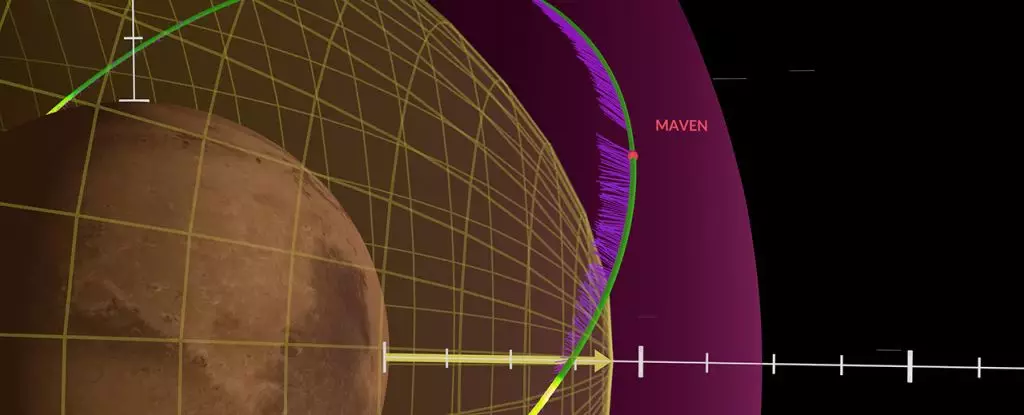In a truly remarkable event, the atmosphere of Mars experienced a significant expansion as a result of a powerful gust of solar wind. On December 26, 2022, the MAVEN spacecraft, stationed in orbit around Mars, observed an abrupt decrease in solar particles when the wind passed by. Interestingly, this occurrence was accompanied by a stunning transformation in the Martian atmosphere. The planet’s magnetosphere and ionosphere greatly expanded, stretching over thousands of kilometers and increasing in size by more than threefold. This incredible phenomenon, last observed in 1999 when Earth’s magnetosphere expanded due to a drop in solar wind, offers a rare opportunity to study how Mars reacts to sudden changes in its surroundings. Additionally, it provides valuable insights into the interactions between Solar System-like planets and the environments influenced by different types of stars.
The awe-inspiring data collected during this event shocked researchers, conveying the sheer magnitude of the decrease in solar wind. Astronomer Jasper Halekas, the lead author of a recent study on this intriguing occurrence, described their initial reaction as almost unbelievable. In response to this unprecedented event, a dedicated team was formed to investigate further. Their efforts have proven fruitful, unearthing a wealth of astonishing revelations during this period.
The solar wind, a constant feature in the Solar System, impacts all the planets within it. Consisting of particles emitted by the Sun in all directions, the solar wind generates ambient pressure throughout the Solar System. This pressure weakens with increasing distance, ultimately diminishing at the heliopause boundary. However, the intensity of the solar wind can fluctuate due to solar activity. For example, the Sun’s surface may exhibit regions of weakened magnetic fields, resulting in a more forceful solar wind composed of greater density and a higher number of particles.
Remarkably, the event that unfolded on December 26, 2022, showcased a different type of solar wind. It comprised two distinct solar winds, with a slower one being absorbed and overshadowed by a faster wind from behind. This merging created a super wind that continued outward. MAVEN diligently recorded the higher particle density produced by this dual solar wind. Once the wind had passed, the spacecraft detected an extraordinary drop in particle density—a rare void of extremely weak and low-density solar wind—coupled with a visible decline in solar wind pressure. The density plummeted by a factor of 100, while the pressure experienced a tenfold decrease.
The Response of the Martian Atmosphere
As the pressure around Mars diminished, its atmosphere reacted in an astonishing manner. Typically, the solar wind pushes against a planet’s magnetosphere, which, in the case of Earth, is essentially a product of its churning molten core. Although Mars lacks a global magnetosphere, it does possess an induced magnetic field. This field arises when magnetic fields embedded in the solar wind become tangled within Mars’ ionosphere. During the event, the ionosphere and induced magnetic field expanded significantly, resulting in the Martian atmosphere metaphorically shedding a too-tight corset. Consequently, the induced magnetic field lost its magnetization, causing the region between it and the solar wind, known as the bow shock, to become considerably calmer than usual. This intriguing phenomenon could provide valuable insights into atmospheric loss on Mars and other similar planets throughout the galaxy. Furthermore, it may play a crucial role in understanding the factors contributing to a planet’s habitability.
The findings of the research team are groundbreaking and have far-reaching implications within the scientific community. The observed response of Mars without the influence of solar wind provides an extraordinary opportunity to study the planet’s behavior under different conditions. By examining Mars in this unique context, researchers gain valuable knowledge about the planet’s potential behavior if it were orbiting a star with less solar wind activity. These findings offer unprecedented insight into the broader characteristics of exoplanets and their ability to sustain habitable environments.
The team is eager to present their remarkable findings at the American Geophysical Union Fall Meeting in 2023. The data collected during this event will undoubtedly pave the way for groundbreaking research in planetary science and deepen our understanding of the complex dynamics of the Solar System.
The extraordinary expansion of the Martian atmosphere resulting from the unexpected solar wind event has captivated scientists and provided a wealth of knowledge about the planet’s behavior under unanticipated circumstances. This astonishing occurrence showcases the invaluable role of spacecraft in orbit around different worlds, allowing us to observe and comprehend the intricate interactions between planets and their celestial surroundings. With each new discovery, we inch closer to unraveling the mysteries of our universe and expanding our understanding of the cosmos.


Leave a Reply